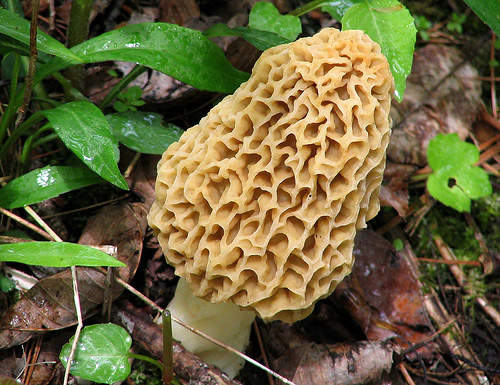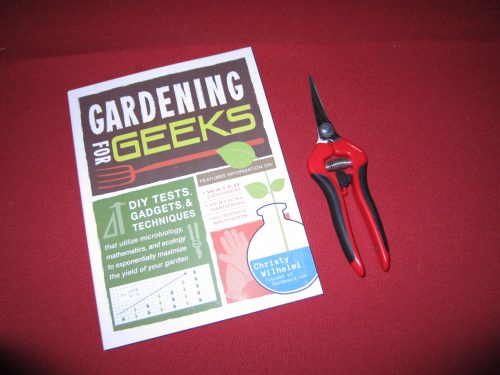Today’s guest post comes from Erika Woodhouse (Great name!…any Emma fans out there?) She’s a blogger and gardener who is slowly trying to turn both her thumbs green. She won’t stop until her beets win a blue ribbon at the Fair. Take it away Erika!
Sometimes nature can provide better food than the most green-thumbed nurturer. If you’ve ever come across a wild strawberry, you know what I’m talking about. The tiny, warm berries burst with more intense flavor than a gallon of store-bought fruit could distill. With that in mind, let’s take a look a few of the most popular targets…
Morels
The filet mignon of the fungi world
Growing up in an extremely rural area, I remember hearing that a local family would sell morels by the giant paper sack, making hundreds of dollars from fancy nationwide restaurants for a few hours of hunting. This was a very hush-hush activity, as morel foraging always is. Though morels will grow in all 50 states, optimal locations and specific season can vary with region.
Morels can spring up in many different areas. Forests, fields, orchards, fence rows, floodplains. Dying trees or decaying felled logs are excellent places to look, as is anywhere that has recently burned. It’s been recommended that old logging roads are excellent places to start. Try not to uproot the fungus; instead, slice it off at the thickest point of the stem.
These mushrooms are delicious prepared with nothing but a quick butter sauté, but for an excellent recipe with wild onions and trout, look below…
Wild Onions
![wildonion[1]](https://gardenerd.com/wp-content/uploads/2014/05/wildonion1-333x500.jpg)
In my neck of the woods, they come up pinkish and they’re everywhere.
Wild onions come in many forms, but the uncultivated shoots of the allium family are uniformly delicious. The onions are generally found on open fields and prairies – drier, rocky areas, even on roadsides. They’re typically most abundant in early May and June and can be so widespread some people consider them weeds.
As always when foraging, be aware of toxic plants that look similar to wild onions, specifically death camas and ‘crow’s poison’. Essentially, if the plant smells like onion or garlic, it is. Wild onions can have pink or white flowers or no flowering buds at all, depending on the species and region.
Sautéed Trout with Morels and Wild Onions
Campfire optional
- 2 tablespoons butter
- 6 small wild onions, finely chopped
- 4 whole brook tour or 2 large rainbows, heads removed
- 5 medium-sized fresh morels, thinly sliced
- 2 tablespoons dry white vermouth or dry white wine
- 2 lemons, cut into wedges
Melt butter in a large cast-iron skillet over medium heat. Add onions and sauté for 6-8 minutes, until translucent. Add trout and cook until the flesh is white, about 5 minutes on each side depending on the thickness of the fish (or 145° on a meat thermometer). When you turn the fish, add the morels. Stir occasionally.
Transfer trout to cutting board to remove backbones. Deglaze the pan with vermouth or wine. When serving, pour the deglazed juices over the fish. Squeeze fresh lemon juice over the trout and morels and serve immediately. Grilled wild asparagus is a wonderful accompaniment.
Asparagus
Wild asparagus is much more dainty than its farmed sisters… [image source]
Oddly, one of the best times to look for an asparagus patch is early fall when the plant is at its tallest, bushiest and bearing bright red fruit. Note the site and head back when spring is in full bloom. In the meantime, as with any foraging cache, tell no one of your new secret spot!
Asparagus is a surprisingly hearty crop that grows all over the place. Canals, riverbeds, irrigation ditches, barrow pits, grassy marshes, ponds – if there’s even the possibility of water being around (but not an extreme amount of humidity) presumably asparagus will follow. Look for the tall, dead stalks from last year’s crop, and honestly, this can even be done from your car, eyeballing alongside fence posts.
Cleansing Spring Smoothie
Spring is the ideal time to flush toxins out of your system… [recipe source]
- 1/2 lb asparagus, blanched or lightly steamed
- 1 carrot
- 1 cup kale leaves
- 1 cloves garlic
- 3/4 cup apple juice
- 30 drops milk thistle extract
- 1 cup ice cubes
Simply blend and enjoy!


![trout2[1]](https://gardenerd.com/wp-content/uploads/2014/05/trout21.jpg)
![asparagus[1]](https://gardenerd.com/wp-content/uploads/2014/05/asparagus1.jpg)
![green[1]](https://gardenerd.com/wp-content/uploads/2014/05/green1.jpg)

